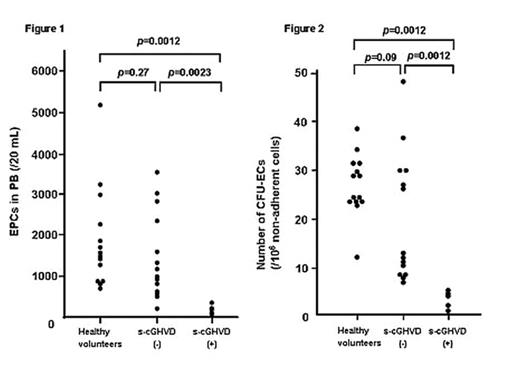Abstract
Chronic graft-versus-host disease (cGVHD) is a common late complications of allogeneic stem cell transplantation (allo-SCT). Some cGVHD patients develop skin lesions. This may be partly because cytotoxic T cells injure skin endothelial cells in GVHD patients. Since the skin lesions in sclerodermatous cGVHD (s-cGVHD) patients resemble those in progressive systemic sclerosis, which is characterized by impaired production of circulating endothelial progenitor cells (EPCs). We investigated whether low EPC production may help to promote the development of skin lesions in s-cGVHD patients. Peripheral blood (PB) was obtained from 14 healthy volunteers and 27 allo-SCT patients. Five patients developed s-cGVHD. In accordance with the Declaration of Helsinki recommendations, all procedures were approved by the institutional review board, and written informed consent was obtained from every participant. First, we assesed the absolute number of CD34+ cells by using a flow cytometric gating strategy on the basis of the International Society of Hematotherapy and Graft Engineering guidelines. The median CD34+ cell frequencies of the healthy volunteers, the 14 non-s-cGVHD, and the s-cGVHD patients were 1.74 /μL PB [IQR 1.34–2.01], 0.85 [0.73–1.62], and 0.41 [0.17–0.42], respectively. The non-s-cGVHD patients had significantly lower frequencies than control (p=0.018) while the s-cGVHD patients had significantly lower frequencies when compared to either the healthy volunteers (p=0.0012) or non-s-cGVHD (p=0.014) groups. Next, the CD34+/CD133+/vascular endothelial growth factor (VEGF) receptor-2+ EPCs were quantified after CD34+ cells were purified by using the magnetic cell sorting separation system. The s-cGVHD patients had significantly lower median circulating EPCs frequencies than non-s-cGVHD patients or control (median 145/20 mL [107–193] vs 1083.5 [669.3–2151]; p=0.0023, and vs 1530.5 [IQR 961.3–2158]; p=0.0012, respectively, Figure 1). We next assessed the ability of endothelial colony in PBMNCs of each group by using the standard CFU-EC assay. The s-cGVHD patients also had impaired median endothelial-forming ability compared to non-s-cGVHD patients or controls (3.8 [IQR 1.0–4.3] vs 12.8 [IQR 8.8–28.8], and vs 26.4 [IQR 23.6–30.6] respectively; p=0.0012, Figure 2). Lastly, the endothelial cell colony-formation potential was evaluated. Serum VEGF and basic fibroblastic factor (b-FGF) concentrations were measured by ELISA. Their VEGF and b-FGF serum levels were also higher than in controls. In conclusion, s-cGVHD patients show impaired vasculogenesis that may limit blood perfusion and could be responsible for the development of sclerodermatous lesions. Administration of EPCs to the skin lesions of s-cGVHD patients may be a novel therapy.
Author notes
Disclosure: No relevant conflicts of interest to declare.


This feature is available to Subscribers Only
Sign In or Create an Account Close Modal